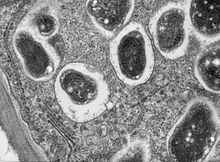Plant growth promoting bacteria

Green biotechnology is a branch of biotechnology with application in agricultural process mainly to reduce dependence on fertilizers, pesticides and other agrochemical products (1). Some examples of this are the use of genetic engineering to make plants that express pest resistance or reduce vulnerability to environmental stresses. In the same way, the use of plant growth promoting bacteria (PGPB) has gained an important place in the world towards a sustainable agriculture. PGPB are a group of microorganisms which are able to confer beneficial effects on plant growth (commonly through mutualistic symbiosis) and development without causing damage to the host (2). PGPB (bacteria) belongs to a broader group PGPM (plant growth promoting microbes), that include other microbes other than bacteria, such as plant growth promoting fungi (PGPF). Those PGPBs colonise the rhizosphere (root or surounding soil) are sometimes called Plant growth promoting rhizobacteria (PGPRs) These microorganisms have to colonize and grow on or around the roots as a necessary step for the establishment of an effective plant–microbe interaction. Some of them are able to enter roots by different mechanisms and establish endophytic populations. PGPB include a variety of bacterial genera such as Gluconacetobacter, Burkholderia, Klebsiella, Azoarcus, Azospirillum, Bacillus, Pseudomonas, Serratia, Thiobacillus, among others, and they are usually classified into two groups (2). The first group affects plant growth indirectly by means of a biocontrol effect preventing the action of phytopathogenic organisms. The other group is usually referred as “biofertilizers”. This group directly stimulates plant growth as a consequence of nitrogen fixation, production of phytohormones, enhancement of mineral availability as well as phytoremediation, but the exact mechanisms by which PGPB stimulate plant growth in vivo are not clearly established. Regardless of the mechanisms involved, the importance of PGPB is their contribution to crop improvement. In the last decade many microorganisms with the ability of plant growth promotion have been reported and, taking into account the wide biodiversity of microorganisms in nature, they are expected to give more solutions that conduce to an environmentally friendly agriculture. PGPB are being considered the potential tools for the future of sustainable agriculture.
- (1) http://en.wikipedia.org/wiki/Biotechnology
- (2) Sophie Mantelin and Bruno Touraine(2003). Plant growth-promoting bacteria and nitrate availability: impacts on root development and nitrate uptake. Journal of Experimental Botany, 55,pp. 27-34 .
- (3) The Plant Microbiome at Work, by Schlaeppi and Bulgarelli (2015), NCBI, DOI, PDF
